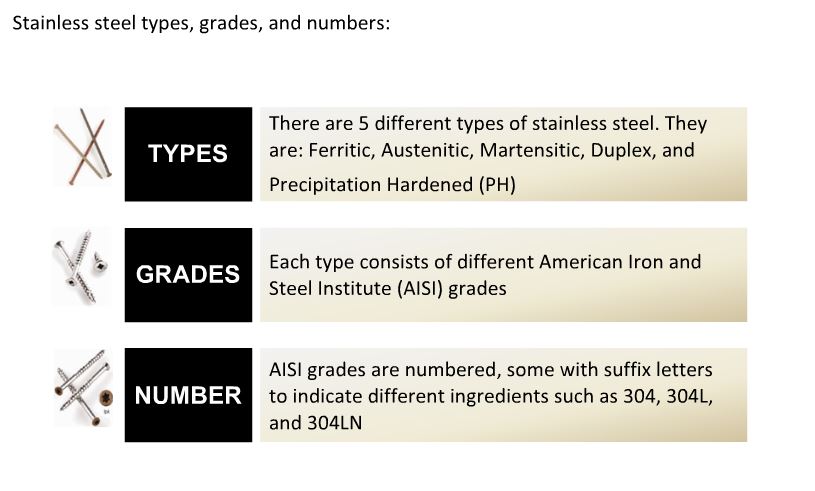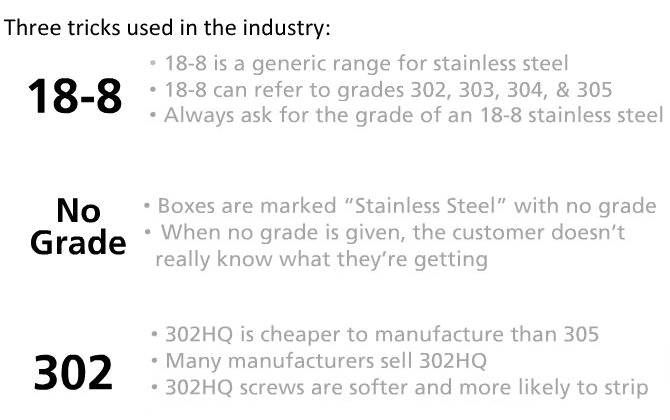Fasten-Ating Facts: 6 Stainless Steel Fastener Myths

With nature's most recent onslaughts, we're reminded of the need for fortitude in our structures, and dependability from the fasteners that secure them. Stainless steel fasteners outlast the elements better than other fasteners, and offer corrosion resistance where others don't.
In addressing 6 myths about this durable metal, we uncover the qualities that make stainless steel fasteners among the most reliable you can buy.

Myth 1. Stainless Steel Fasteners are coated.
Stainless steel is a solid material throughout. In fact, it’s a self-healing metal, which means that if the surface is scratched, the metal naturally creates a transparent, protective layer. The process is known as self-passivation, and the protective layer is chromium oxide. This outer layer keeps the metal beneath from corroding.
Some stainless steel fasteners are treated to a passivation process. The can involve putting fasteners through an acid bath that removes iron from the nail's surface, followed by an oxidizer to force conversion of chromium into an oxide form. This is done to mimic the nature self-passivation process in order to immediately enhance the corrosion resistance of the fastener.
Myth 2 - Stainless Steel Doesn't Stain.
The name “Stainless Steel" is actually a bit deceiving. Grease can leave its mark, minerals like calcium carbonate can build up (think of an old shower head), and hydrochloric acid, for example, can eat away at steel.
Keep in mind that while stainless steel is resistant to corrosion, it’s not corrosion-proof (no metal is). Once it oxidizes, stainless steel does corrode, but at a much slower rate than other metals.

Myth 3. Stainless Steel is a “pure” metal.
Like many metals, including brass and bronze, steel is not an element itself. Rather, it’s an alloy or mix of metals. Regular steel consists of iron + carbon, often with other elements added to achieve desired characteristics. Steel is a strong material, but it’s also prone to rust.
In 1913, Harry Brearly discovered that adding a specific mix of chromium to steel made it resistant to the effects of certain acids. The element chromium is added (at least 10%) to regular steel to make it stain-resistant.
Myth 4. All stainless steel is the same.
There are more than 100 grades of stainless steel, each sub-classified into its own “family."
The most common kind of stainless steel is grade 304, part of the austenitic family, which contain 15 to 30% chromium. Grade 304 stainless steel contains 18% chromium, 8% nickel and a mix of other elements. This versatile material is known as 18/8 stainless, and is typically less expensive than higher-grade stainless steel, as it has less built-in chemical resistance.
You may also be familiar with the second most common type of stainless steel. Grade 316 stainless steel has a greater portion of nickel--and the addition of molybdenum. Molybdenum is resistant to chloride, making it suitable for areas with exposure to harsh chemicals, salted roadways or coastal environments.
Myth 5. Stainless Steel is stronger/weaker than regular steel.
Stainless steel has a low carbon content and can’t be hardened by heat treatment, as regular steel can. So regular, untreated steel isn't as hard as stainless. However, in its hardened state, regular, heat-treated steel is in fact harder than stainless.

Myth 6. Galvanized fasteners are just as good as stainless
Even a well-coated steel nail will corrode before a stainless one. When it corrodes, this can affect the fastener's holding power.
An added risk, there's the potential that the tool driving the fastener (or other abrasion) will chip the corrosion-resistant coating and prematurely begin the oxidation process. Furthermore, the tannins in certain woods (redwoods and cedar, specifically) and the metals used to treat lumber can react to the galvanized coating in fasteners, expediting corrosion.
In many applications, including exterior construction, and in climates with humid, marine or extreme weather conditions, stainless steel is simply the optimal choice for fastener. Stainless steel fasteners aren't just used in construction; many boat and automotive upholsterers use stainless steel staples. To learn more about the differences between galvanized and stainless steel fasteners, see our article Everything to Know About Galvanized Nails.
Shop Nail Gun Depot:



I understand that Monel-fasteners are impervious to all elements, do you find this true?